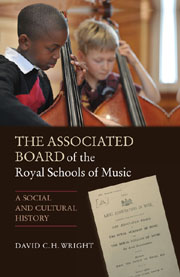Book contents
- Frontmatter
- Contents
- List of Illustrations
- List of Tables
- Dedication
- Preface
- List of Abbreviations
- Miscellaneous Conventions
- Introduction: The Context for a History
- I THE BACKGROUND
- II THE BOARD ESTABLISHED, 1889–1920
- III THE INSTITUTIONAL CULTURE, 1920–83
- IV THE BOARD REVIVED, 1983–2009
- 10 The Reconstitution, 1983–5
- 11 Reconnecting with its Market: the Smith Years, 1983–92
- 12 Redefining its Role: the Morris Years, 1993–2009
- Appendix 1 Speech and Drama Examinations
- Appendix 2 ABRSM Personalia, 1889–2010
- Select Bibliography
- Index
11 - Reconnecting with its Market: the Smith Years, 1983–92
from IV - THE BOARD REVIVED, 1983–2009
Published online by Cambridge University Press: 05 July 2013
- Frontmatter
- Contents
- List of Illustrations
- List of Tables
- Dedication
- Preface
- List of Abbreviations
- Miscellaneous Conventions
- Introduction: The Context for a History
- I THE BACKGROUND
- II THE BOARD ESTABLISHED, 1889–1920
- III THE INSTITUTIONAL CULTURE, 1920–83
- IV THE BOARD REVIVED, 1983–2009
- 10 The Reconstitution, 1983–5
- 11 Reconnecting with its Market: the Smith Years, 1983–92
- 12 Redefining its Role: the Morris Years, 1993–2009
- Appendix 1 Speech and Drama Examinations
- Appendix 2 ABRSM Personalia, 1889–2010
- Select Bibliography
- Index
Summary
Evolving from the ‘old’ to the ‘new’ ABRSM
RONALD Smith brought a very different perspective to the ABRSM. His arrival as the Board's Chief Executive – jettisoning the historic title of ‘Secretary’ – seemed to signal that the ABRSM might, at last, be prepared to accept the need for change. There was a sense at the time that the Board was too much a bastion of the independent school sector, and so Smith's appointment from being an LEA county music adviser was all the more striking. Some saw it as a long-overdue recognition by the Board of the significance of state-school music in British music education. For the post-war development of LEA music provision had given new vitality to the training of young musicians, opening up opportunities through the development of networks of local youth orchestras, ensembles and choirs. The Leicestershire Schools Symphony Orchestra had shown just what could be achieved on a county basis, and its work with the composer Michael Tippett had been the inspiration for others. Meanwhile, there was powerful advocacy for the idea of moving classroom music away from the dominance of music ‘appreciation’ (usually delivered on a talk, chalk and listen basis), which in many children's experience usually entailed passive reception, and to make it a creative experience, involving pupils’ own composition and performance. A big influence here was John Hosier, then a BBC producer, for his use of the BBC's resources to create inspiring music education programmes.
- Type
- Chapter
- Information
- The Associated Board of the Royal Schools of MusicA Social and Cultural History, pp. 181 - 208Publisher: Boydell & BrewerPrint publication year: 2013



